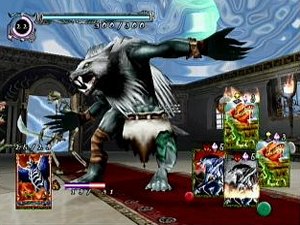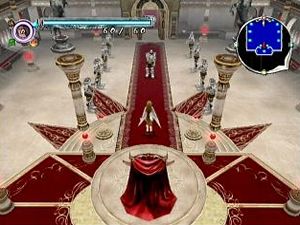Lost in the fog.
In the mystical and often incomprehensible world of RPGs, few enemies are as daunting
as the damp, ornery weather condition known simply as ‘fog’. When the fog rolls
in, you know what’s coming next: zombies, ghouls, monsters, and at least one car
wreck. Time and time again, fog lies at the root of all evil, shedding a path
of destruction in its mist filled wake. They’ve even made movies
about it.
Odd.
I mean, it’s just low clouds, right? What’s the big fuss? “Run for your lives!
It’s CONDENSED WATER VAPOR!” Puffy white clouds never seem to get the same bad
rap. Originally, fog was probably just an excuse for limited system rendering
power, but in this day and age? Why can’t we have the ancient evil of better
graphics?
I digress.
The evil fog strikes again in Lost Kingdoms, the first RPG for the
Gamecube. Lost Kingdoms combines collectible card games with upbeat action
battles to create a game that has a nifty combat system, but sadly not much
else.
The story is ubiquitous at best. The land is filled with an evil fog, and Princess Katia must reunite the 5 kingdoms of the land and find her father, King Feobane. The few friendly NPC characters encountered along the way are just immobile props that dribble a few empty phrases. The story is paper thin and weak, and is little more than a device to get Katia into new territory. With each realm conquered, a new location is revealed on the map.
Katia then dives into the new location and mops up that area’s goal. Sometimes
it is as simple as getting from Point A to Point B; other times it may require
finding and beating a specific opponent. The battles are triggered by random
occurrences, yet instead of being swept into a square battlefield, you are just
walled in and confined to a smaller part of the map.
During battle, you can freely move about to avoid attacks and collect Magic Stones. As you damage enemies, magic stones fly forth, littering the ground in place of blood. It becomes a scramble for these jewels as you fight, replenishing your stock of stones and thus empowering further attacks.
Each card has a set Magic Stone cost. Cards ‘attack’ in different ways depending
on the card’s class: Single, Independent, or Summon. Single attacks function
like action game attacks, such as swinging a sword. Playing an Independent card
sets loose the creature on the card, who then mulls about attacking anything
in its path. A Summon card works like your standard Final Fantasy summon
– big monster comes down from the sky, causes havoc, then goes home.
During the battle, you can skip a card, but you won’t be able to use it again
in the same battle. By giving up a card, you can opt out of the entire battle.
If you can knock an opponent down to their last bit of life, you can attempt
to capture the opponent inside a card and claim victory.
The battle system is governed by the elements. Fire is fierce against Wood,
but weak against Water. In turn, Water dissolves against the might of Earth.
However, the element system tends to get forgotten in the heat of battle. During
a fight, you have access to the first four cards of your deck, each assigned
to one of the four main GC buttons. Yet even though these four cards are overlaid
neatly in the bottom left corner of the screen, complete with class and stone
count, there’s no indication of its element. Your opponents have an indicator
to mark their element, so why not your active cards?
Rather, the elemental information is accessible through menus, forcing you to read up on your cards and understand them better. That’s great for the die hard, but I’d really like to have that information at my fingertips.
Lost Kingdom‘s card system does lead to a nice amount of depth, as
there are more than 100 different cards to familiarize yourself with. Knowing
that a Dragonoid is especially effective against a Red Lizard is useful when
venturing into an area rife with scaly reptilian foes.
 While
While
the strategy isn’t overbearing, recompiling your cards and assembling a stronger
deck for the different areas will allow you to take less damage, be better equipped
for the unique enemies of the region and earn higher ratings. At the completion
of each area, you are assigned a rating. The higher the rating, the more random
cards you receive.
The gameplay view is locked into a slightly tilted overhead perspective. While
there are three levels of zoom, there is no way to switch into a more traditional
third-person camera. This POV has a tendency to remove the player from the action
of the game and lose any empathy for Katia.
The graphics are nothing to write home about. They’re shiny and sharp, but
do little to push the system. The music is also generic and bland. There aren’t
any voices – just a snippet of voice warbling to indicate that you are talking
to someone. This only further removes you from the game.
Fans of collectible card games like Pokemon or Digimon may find
this more interesting than fans of RPGs. There’s a lot of information to be
found in all of the different cards, and many strategies to develop and master
if you put in the effort. When you replay the game, you can go back into beaten
areas to try and raise your ratings.
But the card combat system alone isn’t enough to carry the game. The system
might be intricate, but I also found success slogging through sloppily with
little strategy or understanding of the different cards. When you couple that
with the marginal story and delivery, you’re left with a role-playing experience
that’s not nearly as fresh as it should be.
Plus, the experience is short. Most experienced gamers will beat it handily.
The only real incentive to play after beating it would be to complete your deck,
though Lost Kingdoms also has a two-player mode that allows you to fight
a friend. Unfortunately, by the “fair use rule” in the game, many of the best
cards are deemed ‘unfair’ and are not selectable. The battles become more or
less a back and forth grudge match.
Despite its interesting card battle system, Lost Kingdoms is a relatively
weak start for Gamecube role-playing. Weather forecast calls for rays of light
here and there, but mostly gray skies filled with…oh, just guess.

-
Card collecting depth
-
Nice battle system
-
Short, weak story
-
Average graphics and sound
-
Elemental information buried in menus











